


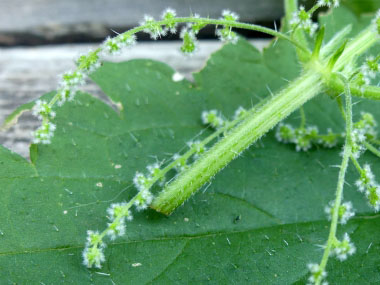
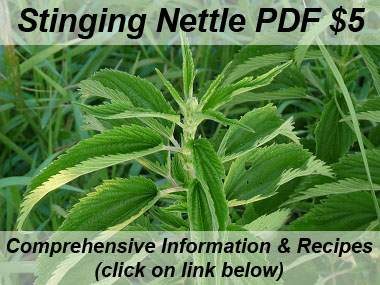
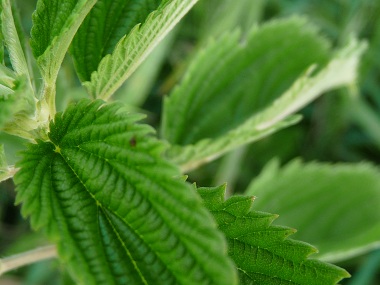
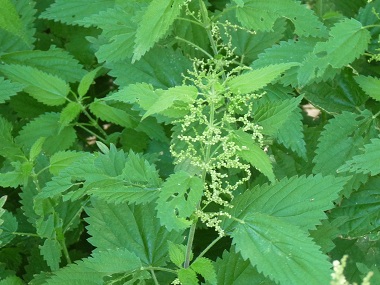
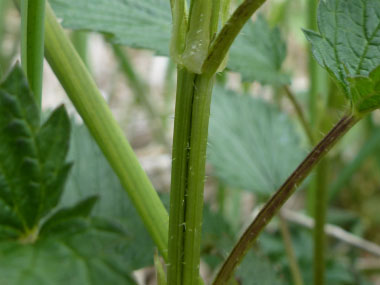
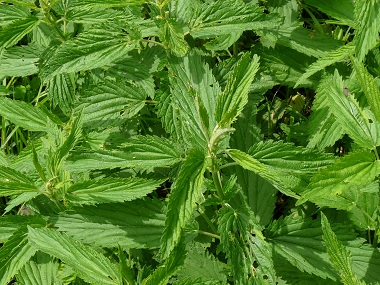
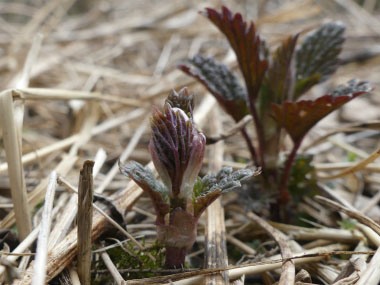
For comprehensive information (e.g. nutrition, health benefits, recipes, history, harvesting tips, etc.) please check out our Stinging Nettle PDF magazine.
Stinging nettle is a large, rhizomatous perennial wild edible plant that can grow quite tall. Originally from Europe and Asia, this plant has sharp hairs that break easily and can irritate or sting when the plant is touched; however it is a vitamin-rich food source as well as a remedy for various medical conditions. Stinging nettle has been used for hundreds of years to treat painful muscles and joints, eczema, arthritis, gout, and anemia. Fibrous stems of mature plants can be used to make twine, fishing nets, snares and other items. Nettles were traditionally dried and fed to livestock throughout winter. In Europe the plants are harvested commercially for extraction of the chlorophyll, which is used as a safe green colouring agent (E140) in foods. There are between 30 and 45 species of flowering plants of the genus Urtica in the family Urticaceae.
Distinguishing Features
Sharp, stinging, tiny hairs encompass this entire plant. Stinging nettles have tiny, fuzzy-like white flowers. This plant has a spinach-like taste.
Caution: When collecting stinging nettle always cover up all exposed skin. The swollen base of each tiny, hollow hair contains a droplet of formic acid. When the hair tip pierces the skin, the acid makes it into the skin causing anywhere from an annoying itch or burning that can last several minutes or a couple of days. Rubbing the stings with stinging nettle root or jewelweed has been used to suppress the itch/burning sensation.
Flowers
This is a dioecious (staminate and pistillate flowers on different plants) plant with very small flowers. Staminate flower is greyish yellow: four tepals (like sepals). The flowers have four stamens and yellow anthers. Pistillate flower has four tepals in different-sized pairs, are greyish green and hairy. It has a single carpel and the stigma is brush-like. Inflorescence is catkin-like, 4–8 cm (1.6–3.2") long.
 Fields
of Nutrition has medicinal benefits and vitamin/mineral content of Stinging Nettle.
Fields
of Nutrition has medicinal benefits and vitamin/mineral content of Stinging Nettle.
Leaves
This plant has fine toothed, tapered, somewhat heart-shaped leaves that are 3-15 cm. Thin catkins of tiny green flowers grow from the leaf axils.
Height
Generally 1 metre but can grow up to 2 metres depending on location and soil condition.
Habitat
Nettles generally appear in the same locations every year. They thrive in rich soil, moist woodlands, thickets, disturbed areas, along partially shaded trails and riversides.
Edible Parts
Leaves, stems and roots are edible. Young leaves are preferable however, no matter how far into the growing season be sure to remember that until dried or cooked, stinging nettle leaves will have those stinging hairs – never eat them raw! Nettles make an excellent spinach substitute and can also be added to soups and stews. Nettle beer is brewed from the young shoots. Nettle root is used for medicinal purposes including enlarged prostate and when there is difficulty in urination due to BPH. Nettle tea made from the root can help urinary ailments. Tea made from the leaves is rich in iron and can aid coagulation and the formation of hemoglobin.
Other Name
Nettle.
Similar Plants
False Nettle, White Dead-Nettle.
Recipes
Frosted Raw Cacao Nettle Bites, Leek and Nettle Soup, Wild Mustard Pesto, Nettle Pesto, Stinging Nettle Beer, Nettle Cake, Stinging Nettle Donuts, Stinging Nettle Hummus, Stinging Nettle Oat Cookies, Stinging Nettle Soup, Wild Roasted Cabbage, Wild Scalloped Potatoes
To support our efforts please browse our store (books with health benefits, etc.).
Winter Survival Food Handbook

PDF Plant Magazines
Types of Wild Food
Geographic Zones Seasons
Disclaimer
EdibleWildFood.com is informational in nature. While we strive to be 100% accurate, it is solely up to the reader to ensure proper plant identification. Some wild plants are poisonous or can have serious adverse health effects.
We are not health professionals, medical doctors, nor are we nutritionists. It is up to the reader to verify nutritional information and health benefits with qualified professionals for all edible plants listed in this web site. Please click here for more information.
Why Edible Wild Food?
- Food costs are rising
- Free, wild food is readily abundant
- Wild food adds nutrition to your diet
- Wild food can help treat various medical conditions







